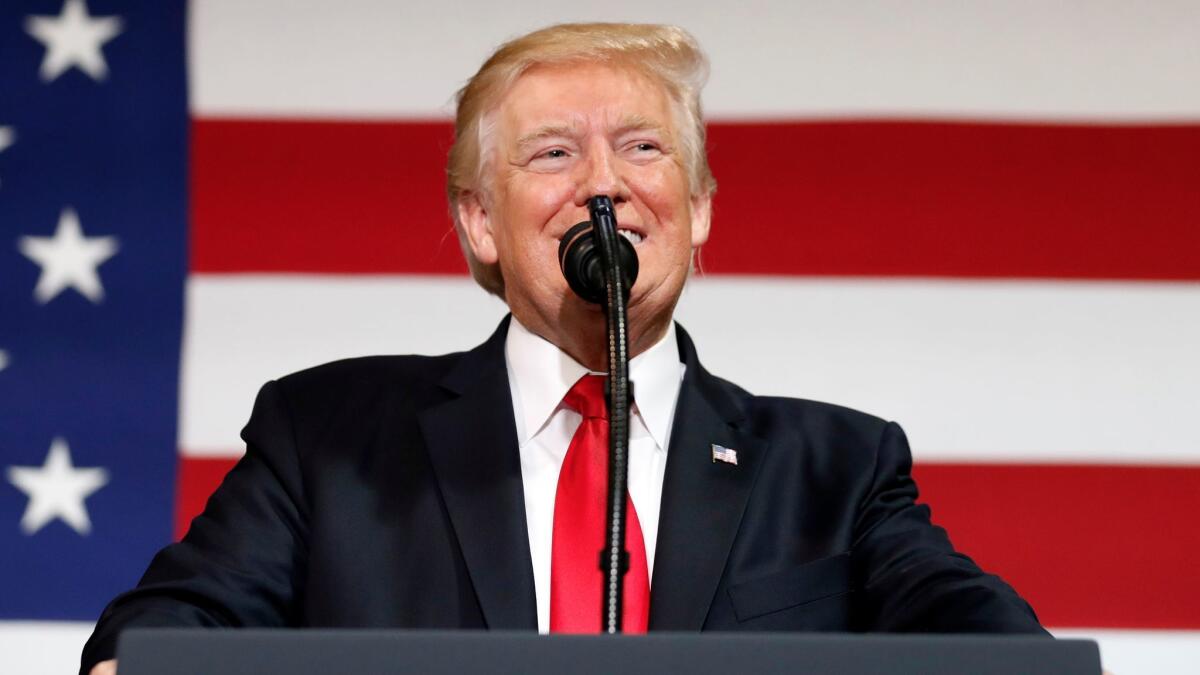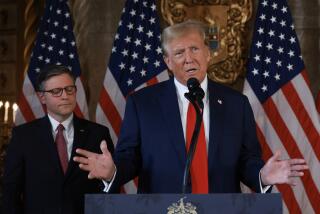Op-Ed: If you listen closely, you can hear Trump’s tax plan shrinking

Tax cuts are the centerpiece of President Trump’s economic agenda. That’s how he’ll deliver on his promise to create “millions” of new jobs and restore manufacturing in the heartland, he says.
But for Republicans in Congress, after their failure to repeal President Obama’s healthcare law, tax reform is more than just another political battle. It’s an existential one.
“If we don’t get tax reform done, we’re dead,” Sen. Mike Lee, the refreshingly blunt senator from Utah, said last week. “We might as well flip up our tent and go home.”
If Trump and his allies pass an ambitious tax bill, they will be able to ascribe every subsequent improvement in the economy — every job created, every spike in the stock market — to their own handiwork, whether they deserve the credit or not.
If they’re stymied, they’ll have to prove that they didn’t merely inherit a healthy economy from Obama. The increase in business confidence that followed the election, the “Trump bump,” may disappear if the promise of tax cuts turns out to be a mirage.
Seven months after Trump’s inauguration, the president and his allies still don’t have a tax plan.
So it’s not a good sign that the prospect of passing a tax bill already looks eerily like the repeal of Obamacare: a sure thing that turned into a debacle.
Seven months after Trump’s inauguration, the president and his allies still don’t have a plan. Trump launched his fall tax campaign last week with a speech in Missouri, but it was largely content-free.
Treasury Secretary Steven Mnuchin, a political neophyte, initially said he hoped to pass a bill by August. Now he promises a “blueprint” will arrive — not pass — in September.
It’s not clear that GOP leaders in the House and Senate are even on the same page. Democrats, meanwhile, are largely unified in opposition to almost anything the administration is likely to propose.
If you listen closely, you can hear the administration’s initial ambitions for its tax bill slowly shrinking. Last week, Trump said he still wants to enact a sweeping reform of individual income taxes, “potentially the biggest ever.” But full-scale tax reform — the kind that lowers tax rates, eliminates deductions and simplifies tax returns — takes years and, usually, bipartisan cooperation. The last big reform, in 1986, was the fruit of more than three years of talks. Trump and his Republicans have given themselves three months. And they’ve already decided against seeking help from Democrats, who would have demanded painful compromises.
The president said last week that he wanted to work with Democrats, but charged that they are “looking to obstruct tax cuts and tax reforms, just like they obstructed so many other things.” Instead, Trump and his lieutenants are increasingly focused on only one part of their initial broad agenda: a cut in corporate taxes from the current top rate of 35%.
That could be a hard sell. Public opinion polls show most Americans think corporations pay too little in taxes, not too much. It would have been easier to sell an individual tax cut, especially one aimed at the middle class. This was the argument of Steven K. Bannon, the renegade Trump advisor who wanted to turn the GOP into a “workers’ party.” But Bannon isn’t in the White House anymore. On taxes, Trump’s chief economic advisers, Mnuchin and Gary Cohn, are in charge — and they aren’t populists.
There are defensible policy arguments for lowering the top corporate tax rate. Obama proposed a corporate tax cut, too, although not as deep as Trump’s. But last week, Trump made it sound like a panacea. “We must reduce the tax rate on American businesses so they keep jobs in America, create jobs in America, and compete for workers right here in America,” he said. “Lower taxes on America’s businesses means higher wages for America’s workers.”
The problem with that sales pitch is that it’s only partly true — at best. Nonpartisan studies, including one from the Treasury Department, suggest that about 70% of the direct benefits of a corporate tax would go to owners and investors, not workers. Economic theory holds that those owners and investors will use some of that money to expand their businesses, which could include hiring more workers — a classic “trickle down” effect. But it’s not likely to have an immediate, visible impact on jobs or incomes.
Meanwhile, Trump is still promising a broad tax cut for the middle class, one that he may not win. In short, he’s already over-promising — just as he did on healthcare, when he said that GOP bills wouldn’t deprive anyone of their health insurance.
The good news for Trump and his allies is that they don’t need to persuade every voter. If the tax bill won’t blow a hole in the deficit, they need only 50 Republican votes in the Senate.
But there will still be battles, just as there were on healthcare. And Republicans will be waging those battles with the same president who repeatedly disrupted their attempts to repeal Obamacare. As healthcare showed, one GOP strategist told me, “We’re a party that doesn’t know how to sell ideas any more.”
The most likely outcome, especially against a year-end deadline, is that Republicans will opt for a “skinny” lowest-common-denominator bill, which probably means a corporate tax cut. The skinnier the bill, the smaller the impact — and the weaker the GOP’s claim to economic wizardry.
Twitter: @DoyleMcManus
Follow the Opinion section on Twitter @latimesopinion or Facebook
More to Read
A cure for the common opinion
Get thought-provoking perspectives with our weekly newsletter.
You may occasionally receive promotional content from the Los Angeles Times.











